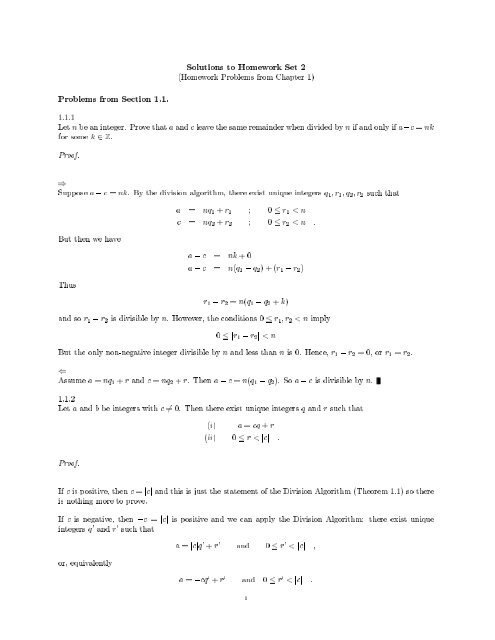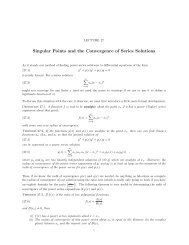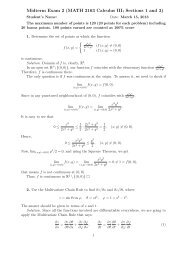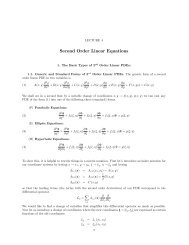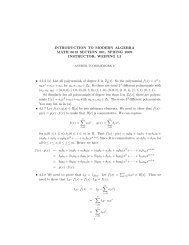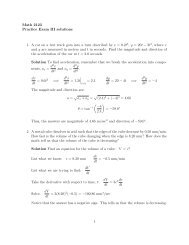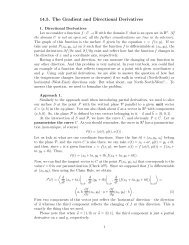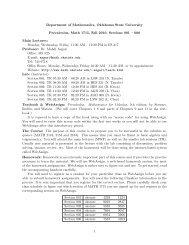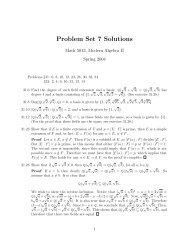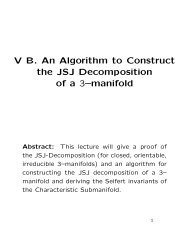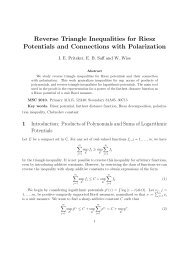Create successful ePaper yourself
Turn your PDF publications into a flip-book with our unique Google optimized e-Paper software.
1.2.5that if GCD(a, c) =1andGCD(b, c) = 1, then GCD(ab, c) =1.Prove4Proof.LetS = {common divisors ofa andb}T = {common divisors ofa and(a + b)}We will show that these two sets coincide.Suppose s ∈ S. Then there exist x, y ∈ Z such thata = xsb = ysThus,a + b = sx + sy = s(x + y) ,and so a + b is divisible by s. Soany s ∈ S is also an element of T.Suppose t ∈ T. Then there exist u, v ∈ Z such thata = uta + b = vt .Hence,b = vt − ut = t(v − u) ,and so b is also divisible by t. So any element t ∈ T is also an element of S.Thus, S = T. SoGCD(a, b) = Max(S) = Max(T) =GCD(a, a + b) .Proof.Suppose GCD(a, c) = 1 and GCD(b, c) = 1. Then by Theorem 1.3, there exists integers u, v, x, y such that= ua + vc1= xb + yc1But then1 = 1· 1= (ua + vc)(xb + yc)= (ux) ab +(uay + vxb + vyc) cThus,(4)1=u ′ (ab) +v ′ cwithu ′ = uxv ′ = uay + vxb + vyc .
of all, it is clear that if c and b have no common fac<strong>to</strong>rs, and t is a fac<strong>to</strong>r of b, then c and t have noFirstfac<strong>to</strong>rs. Put another way; if t | c and GCD(c, b) = 1 then GCD(t, b) =1.common1.2.6Prove that if a, b, u, v ∈ Z are such that au + bv = 1, then GCD(a, b) =1.(a)note that the condition au + bv = 1 implies that a and b cannot both be zero. According <strong>to</strong> CorollaryFirstan integer d is the greatest common divisor of a and b if and only if1.4,d | a and d | b(i)if c | a and c | b, then c | d.(ii)now note that the right hand side is divisible by d but the left hand side is not, since d is presummedButbe greater than 1. Hence we have a contradiction unless d =1.<strong>to</strong>5Now let t be any common divisor of ab and c. Then, by definition, there exists s, t ∈ Z such thatab = rtc = stSo we can rewrite (4) as1=u ′ rt + v ′ st =(u ′ r + v ′ s) t ;from which it is clear that t | 1. Hence, t = ±1. Hence the greatest common divisor of ab and c is 1.∗∗∗∗∗∗∗∗Here is an alternative proof.Now suppose that d = GCD(c, ab). Then d ≥ 1 and there exist integers x and y such thatc = xdab = yd .Since d | c and GCD(a, c) = 1, by the remark above above, we have GCD(t, a) =1.Similarly, t divides c and GCD(b, c) = 1 implies GCD(t, b) =1.Now we apply Theorem 1.5.t | ab and GCD(t, a) =1 ⇒ t | b.But GCD(t, b) = 1. Hence t =1.Proof.Suppose now that d = GCD(a, b) > 1. Thena = sdb = td .But then we have1=sdu + tdv = d(su + tv)(b) Show by example that if au + bv = d>0, then GCD(a, b) neednotbed.Example.
1.3.1p be an integer other than 0, ±1. Prove that p is prime if and only if for each a ∈ Z, eitherGCD(a, p) =1LetProof.⇒∈{±1, ±p}. Hence either GCD(a, p) =1orGCD(a, p) =|p|. In the latter case we have p | a. So eithersp) =1orp | a.GCD(a,p has the property that for every integer a, either GCD(a, p) =1orp | a. If p is not prime thenAssumeexist s, t ∈ Z such thattheret is a divisor of p, GCD(t, p) =t ≠ 1. Therefore, p | t. But this is impossible since |t| < |p|. Hence pSincebe prime.must1.3.2p be an integer other than 0 ± 1 with this property: Whenever b and c are integers such that p | bc,Letp is an integer ≠0, ±1 such that whenever p | bc then p | b or p | c. Let s be a divisor of p. ThenSuppose= sq for some integer q and we havep6Take a =3,u =1,b =3,v = 1. Thenau + bv =5butGCD(3, 2) = 1 .Problems from Section 1.3or p | a.If p is prime then the only divisors of p are ±1 and±p.So if s is a common divisor of a and p, then⇐(Proof by Contradiction)p = stand1 < |s| ≤|t| < |p| .then p | c or p | b. Prove that p is prime.Proof.sq | bc ⇒ sq | b or sq | cIn particular, taking b = s and c = q, wehavesq | s or sq | q .But this implies eithers = ±1 and q = ±pors = ±p and q = ±1 .Hence the only divisors of p are ±1 and ±p; and so p is prime.
1.3.3that if every integer integer n>1 can be written in one and only one way in the formProven = p 1 p 2 ···p rTheorem 1.11, we know that there exists a prime fac<strong>to</strong>rization of n that is unique up <strong>to</strong> changes in theByof fac<strong>to</strong>rs and flips in the sign of pairs of fac<strong>to</strong>rs. The statement above just removes the remainingorderin the conclusion of Theorem 1.11. All prime fac<strong>to</strong>rs are now required <strong>to</strong> be positive, so thereambiguitycannot flip the sign of terms; and the order of fac<strong>to</strong>rs is fixed <strong>to</strong> coincide with their normal ordering asone1.3.4that if p is prime and p | a n , then p n | a n .Prove<strong>to</strong> Corollary 1.9, if p | a n , then p | a since a n = a · a · a ·····a. Butthen a = pq for some q ∈ Z.Accordinga n = p n q n ,andsop n divides a n .Hence1.3.5Prove that there exist no nonzero integers a, b such that a 2 =2b 2 .(a)a = p 1 p 2 ···p rthe two integers a 2 and 2b 2 have, respectively, an even number and an odd number of prime fac<strong>to</strong>rs,Since 2 can not equal 2b 2 .a√√rational; i.e., 2= a bis 2a, b ∈ Z, b ≠ 0. Thenwith√= a 2bas we have just seen cannot be satified by any non-zero integers a and b. Hence we have a contradiction.which √ 2 can not be rational.So7where the p i are positive primes such that p1 ≤ p2 ≤···≤p r .Proof.integers.Proof.Proof.According <strong>to</strong> the Fundamental Theorem of Arithmetic, a and b have prime fac<strong>to</strong>rizations of the formb = q 1 q 2 ···q s .But thena 2 = p 1 p 1 p 2 p 2 ···p r p r (2r prime fac<strong>to</strong>rs)2b 2 = 2q 1 q 1 q 2 q 2 ···q s q s (2s + 1 prime fac<strong>to</strong>rs)(b) Prove that √ 2 is irrational.Proof.Supposean integer. Squaring both sides of this equation we getis 2 = a 2 2b


